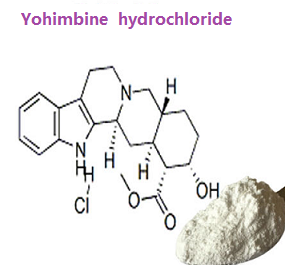|
| | Yohimbine hydrochloride Chemical Properties |
| Melting point | 288-290 °C (dec.)(lit.) | | alpha | 99 º (c=1%, H2O, dry subst) | | refractive index | 103 ° (C=1, H2O) | | storage temp. | Keep in dark place,Inert atmosphere,Room temperature | | solubility | H2O: 10 mg/mL | | form | powder | | color | white to off-white | | optical activity | [α]/D 100±5°, c = 1 in H2O | | Sensitive | Light Sensitive | | Merck | 14,10102 | | InChIKey | PIPZGJSEDRMUAW-VJDCAHTMSA-N | | SMILES | N1C2=C(C=CC=C2)C2=C1[C@@]1(C[C@]3([C@](CC[C@@H]([C@@H]3C(OC)=O)O)([H])CN1CC2)[H])[H].[H]Cl |&1:9,11,12,15,16,r| | | LogP | 2.201 (est) | | CAS DataBase Reference | 65-19-0(CAS DataBase Reference) | | EPA Substance Registry System | Yohimbine hydrochloride (65-19-0) |
| Hazard Codes | T | | Risk Statements | 23/24/25-33-23/24 | | Safety Statements | 22-36/37/39-45-24/25 | | RIDADR | UN 1544 6.1/PG 2 | | WGK Germany | 3 | | RTECS | ZG1015000 | | TSCA | Yes | | HazardClass | 6.1(a) | | PackingGroup | II | | HS Code | 29339900 |
| | Yohimbine hydrochloride Usage And Synthesis |
| Overview | Yohimbine hydrochloride is an α2-adrenergic receptor antagonist and increases the firing rate of the locus coeruleus with a resultant increase in sympathetic outflow (Redmond, 1987). Oral and intravenous yohimbine causes an increase in MHPG and blood pressure in healthy human subjects (Charney et al., 1982d; Goldberg et al., 1986). Depressed patients demonstrate an increased cortisol and blood pressure response to intravenous yohimbine compared with healthy subjects, while plasma MHPG is not significantly different between the two groups of subjects (Heninger et al., 1988). The effects of acute or chronic antidepressant treatments on the neuroendocrine or behavioural responses to yohimbine in depressed patients have not been studied.
 | | Side effects | Yohimbine hydrochloride has been associated with high blood pressure, increased heart rate, headache, anxiety, dizziness, nausea, vomiting, tremors, and sleeplessness. It can be dangerous if taken in large doses or for long periods of time. It should not be taken in combination with monoamine oxidase (MAO) inhibitors, as effects may be additive.
Yohimbe should be used with caution when taken with medicines for high blood pressure, tricyclic antidepressants, or phenothiazines. People with kidney problems and people with psychiatric conditions should not use yohimbe. Women who are pregnant or breastfeeding should not take yohimbe.
The Journal of Medical Toxicology reports an instance of refractory priapism associated with ingestion of yohimbe extract, and there are other scattered reports of adverse reactions. However, may studies report it to be generally well tolerated.
| | Mechanism of action | Yohimbine hydrochloride is a pre-synaptic alpha 2-adrenergic blocking agent. The exact mechanism for its use in impotence has not been fully elucidated. However, yohimbine may exert its beneficial effect on erectile ability through blockade of central alpha 2-adrenergic receptors producing an increase in sympathetic drive secondary to an increase in norepinephrine release and in firing rate of cells in the brain noradrenergic nuclei.Yohimbine-mediated norepinephrine release at the level of the corporeal tissues may also be involved. In addition, beneficial effects may involve other neurotransmitters such as dopamine and serotonin and cholinergic receptors.
| | Pharmacokinetics | Yohimbine hydrochloride—an α2-adrenoceptor antagonist that is approved for treatment of erectile dysfunction—may increase BP.1,2,In normal volunteers and in patients with panic disorders, oral administration at doses used clinically may slightly increase BP.1 However, in hypertensive patients oral yohimbine was reported to induce a significant increase in mean arterial pressure.The magnitude of the pressor response was related to baseline norepinephrine levels and to the yohimbine-induced increment in plasma norepinephrine levels.Thus yohimbine increases BP by stimulation of the sympathetic nervous outflow, and the drug should be administered with caution to patients with evidence for increased basal sympathetic outflow or those undergoing concurrent treatment with tricyclic antidepressants or other drugs that interfere with neuronal uptake or metabolism of norepinephrine.
| | Chemical Properties | white to slightly yellow powder, slightly fragrant, slightly bitter taste, easily soluble in chloroform, soluble in methanol, ethanol, slightly soluble in water. | | Uses | Yohimbine hydrochloride is an Indole alkaloid with α2-adrenergic blocking activity. It is an alpha adrenergic blocker, mydriatic, antidepressant that used in the treatment of neurological disorders and erectile dysfunction. | | Uses | Yohimbine hydrochloride is an α2-adrenergic receptor antagonist. It blocks the central α2-adrenegic receptors in the brain, thus preventing and reducing the effects of xylazine, an α2-adrenergic agonist. The sedative effects and respiratory depression that accompany xylazine administration are both antagonized and reversed by yohimbine. Yohimbine hydrochloride also produces an antidiuretic effect, and increases heart rate and blood pressure. | | General Description | Yohimbine hydrochloride is an indole alkaloid derived from the tree bark. It is an antagonist of α2-adrenergic receptors in the brain, reducing the effects of xylazine, which is an α2-adrenergic agonis. | | Biochem/physiol Actions | Yohimbine is derived from the Coryanthe yohimbe tree cortex. It is an alkaloid. Yohimbine hydrochloride is an α2-adrenergic receptor antagonist. It blocks the central α2-adrenergic receptors in the brain, thus preventing and reducing the effects of xylazine, an α2-adrenergic agonist. The sedative effects and respiratory depression that accompany xylazine administration are both antagonized and reversed by yohimbine. Yohimbine hydrochloride also produces an antidiuretic effect, and increases heart rate and blood pressure. It is useful in treating erectile dysfunction and promotes sexual functioning. | | Veterinary Drugs and Treatments | Yohimbine is indicated to reverse the effects of xylazine in dogs, but
it is being used clinically in several other species as well.
Yohimbine may be efficacious in reversing some of the toxic effects
associated with other agents (e.g., amitraz) and can be used
prophylactically before amitraz dips. | | storage | Store at RT |
| | Yohimbine hydrochloride Preparation Products And Raw materials |
|